Laser Tattoo Removal
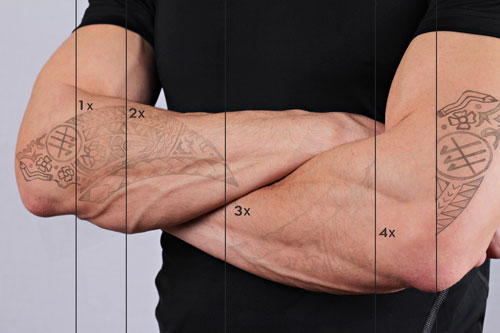
How it works
Picosecond lasers utilize revolutionary photo-acoustic technology to remove tattoos, age spots, sunspots, and freckles, treat melasma, rejuvenating the skin quickly, safely, and effectively. Picosecond lasers work well on all skin tones, and ink colors, all with little to no downtime.

Picosecond lasers work by breaking up ink and pigment particles into much smaller particles which then allows your own body to begin the process of clearing them. By delivering powerful pulses in extremely short durations, treatments are much safer compared to traditional laser treatments which rely on heat to damage and remove pigment. Picosecond lasers direct a beam of light energy onto the area being treated using a laser pulse of 750 picoseconds efficiently targeting different colors and types of ink using two different laser wavelengths. The high-peak-power and ultra-short pulses of energy delivered by picosecond lasers target tattoo ink particles and shatter them without damaging the surrounding tissue. Cellular macrophages and your body’s lymphatic system then begin the process of clearing and removing the unwanted pigment. Fading of ink occurs over a six-to-eight-week period.
faqs
Laser tattoo removal is safe. Picosecond technology is FDA approved, and effective. What separates picosecond lasers from traditional lasers is that it is suitable for use in all Fitzpatrick I-VI skin types and can be used safely to treat all skin tones.
Tattoo ink is deposited deep within the skin. To target all the ink in the skin, multiple treatment sessions are required. Factors, which include ink color, type of ink, depth of ink particles, ink particle size, tattoo age, and location in the body determine the number of treatments required to fully clear a tattoo. With picosecond lasers tattoo removal, it is common to begin seeing results following one to two sessions. Patients may require between six to ten treatments depending on the size, age, color, and depth of the tattoo. Dr. Hudson recommends a minimum of six weeks between treatments. This allows your skin time to clear the ink particles and heal beneath the surface before the next laser treatment. While it may take more than 8 months to completely erase a tattoo, you will notice your tattoo fades a little after every treatment session.
Unfortunately, there are no guarantees that laser tattoo removal treatment will be able to completely remove a tattoo in its entirety. Utilizing the advanced technology of picosecond laser technology allows us to obtain as close to a guarantee as possible. It is important to realize that some ink colors are more difficult to clear than others. Colorful tattoos are more challenging to remove than darker ones. Synthetic inks may require more treatments as these tend to be more difficult to fade. Since darker colored ink absorbs more light, these will fade more rapidly than lighter colors.
Unfortunately, laser tattoo removal is not without some discomfort. When the device is passed over the skin, clients will experience a heating sensation. Most patients find the treatment uncomfortable. Fortunately, treatment sessions are quick. To reduce discomfort, Dr Hudson applies a topical numbing cream thirty minutes prior to the procedure. Lidocaine can sometimes be infiltrated subcutaneously into the treatment area to reduce discomfort. The Zimmer Cryo- chiller is also used to blow cool air onto the treated area to lessen discomfort during a treatment. As ink fades, clients experience less discomfort during subsequent treatments since less pigment absorbs less laser energy from the laser.
Most patients experience redness and swelling immediately following a treatment. These side effects are temporary and will resolve within twenty to forty-eighth hours. Tenderness and blistering rarely occur. Blisters and scabs may also form during the healing process. Proper wound care is essential to prevent infection and scarring. Patients failing to properly care for any blistering place themselves at risk for infection and scarring. Additionally, the area undergoing treatment may be sore for a brief period; however, any discomfort should not interfere with your normal day-to-day activities. Scarring is extremely uncommon in laser tattoo removal. In most cases, any scarring that occurs was already present from the original tattooing process.
Patients can resume regular activities immediately following laser treatment. An antibiotic ointment and bandage are applied over the treatment site which is typically left in place for twenty-four hours.
It typically requires 6-10 treatments to remove or fade a tattoo. Some patients may require more treatments, while others may require fewer treatments. This can vary from person to person based upon a variety of factors. These factors include tattoo color, patient skin tone, tattoo location, patient health status and lifestyle, age of the tattoo, and the amount and depth of ink placement.
Tattoo color is a key factor when considering laser tattoo removal. Black ink or darker ink is the easiest to remove or fade since black pigment absorbs all wavelengths of light. This is followed by reds and warmer tones such as orange and yellow, followed by blues and greens. Medium blues and green are the most difficult colors to fade. Patient skin tone is another factor which affects the rate of tattoo clearance. Fitzpatrick Skin Type is used to estimate how many treatments will be required to remove a tattoo. There are six different skin types, ranging from very fair to very dark. Tattoos treated on fair, light skin individuals tend to experience more rapid results compared to those performed on darker skinned clients. Next, layered or cover-up tattoos may require additional time and treatments to fade. With laser tattoo removal, only one layer can be treated at a time. So, with a cover-up tattoo, many more layers of ink will need to be targeted to treat. As a result, more treatments will be necessary.
Tattoo location is yet another factor which influences the rate of fading of laser treated tattoos. As the shattered ink is cleared by your lymphatic system, it is easy to understand why tattoos in certain areas of the body fade more rapidly than others. The closer to the heart, the quicker the tattoo will fade, and the sooner one might see results. This is why tattoos on the hands and feet require a bit longer to fade. The current health status of the patient is another factor that may influence the rate at which a tattoo fades. Health and lifestyle play a significant role. For example, clients that smoke or drink regularly are already processing and eliminating a significant level of toxins within their body. As a result, some clients may not have the detox capacity to clear tattoo ink as effectively. This can slow the process and result in the necessity of more treatments. The amount of ink present is yet another factor. A lighter or less intense tattoo fades easier and faster. The denser the ink, the longer the tattoo will be required for it to fade.
The age of the tattoo also influences the rate of clearing. Older tattoos tend to fade easily because the body has already been trying to break down the ink over the years. This is why a tattoo that is twenty years old often appears more faded, compared to a tattoo that might only be six weeks old.
Lastly, whether the tattoo is professional, or amateur is another factor which influences the rate of tattoo removal. Professional tattoos tend to be more difficult to remove. When a tattoo is performed professionally, the tattoo artist places the ink deeper within the dermis, the deeper layer of the skin. The deeper the ink placement, the more treatments will be required to remove the tattoo. Tattoos performed by an amateur with a tattoo gun tend to be more superficial, having not been placed too deep within the dermis, and as such may not require as many treatments. Similarly, stick and poke tattoos are the easiest and quickest to remove because the ink is placed much more superficially.
cost
The cost of removing a tattoo is dependent upon several factors such as the size and complexity of the tattoo, how much ink is present, the age of the tattoo and the type of ink used. Cost varies from as low as $99.00/session to several hundred dollars, depending on the level of treatment you require. To obtain a more accurate estimate of the cost, we recommend coming in for a free consultation.
results
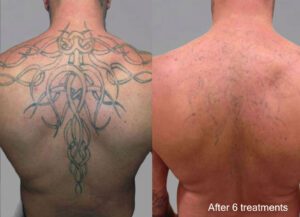
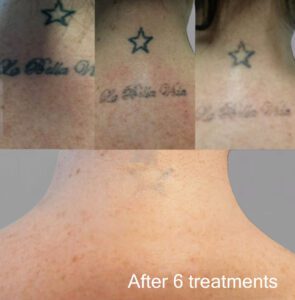
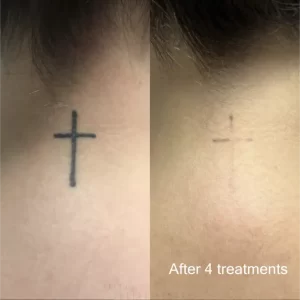
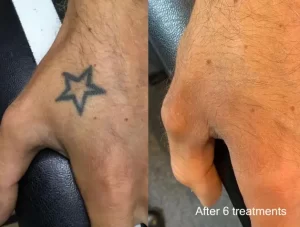
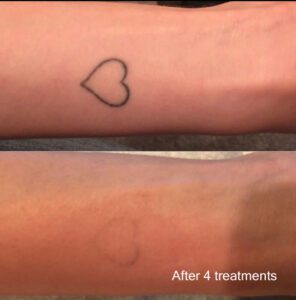
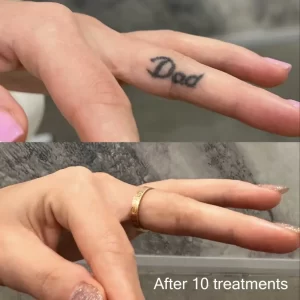
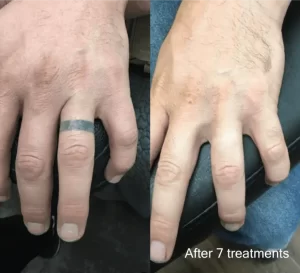
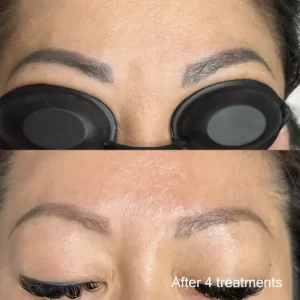
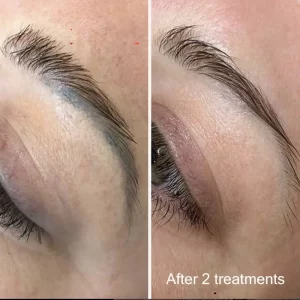
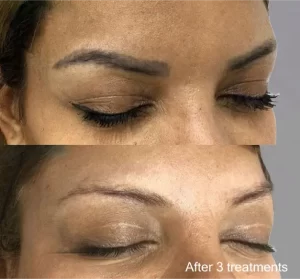
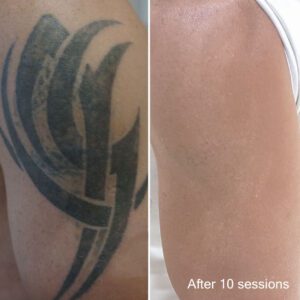
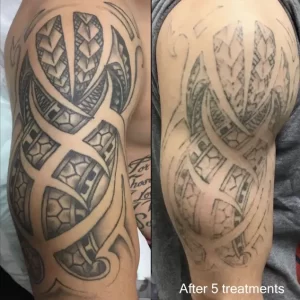
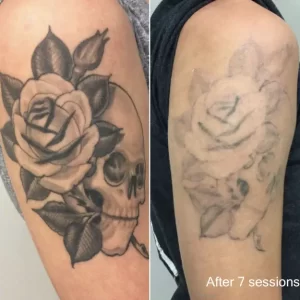
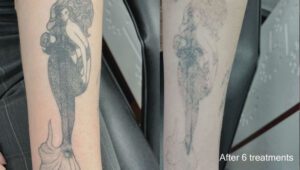
*Individual results may vary with different patient experiences.
*A series of treatments may be required for desired results.
